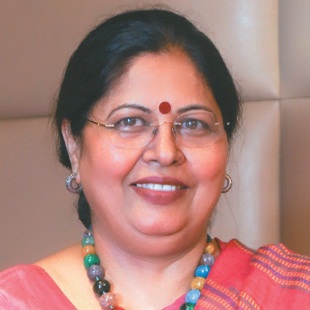Women and Leadership in the G&J Industry

The Indian gems & jewellery industry is by and large a male-dominated one. A few years ago, it was quite rare to see a woman in a leadership position. However, times are changing and this once male-dominated industry is on its path to becoming more inclusive. There are more leadership opportunities opening up for women across all verticals. By Kavita Parab
Jewellery industry - be it global or domestic - thrives on its female consumers. The industry is for the women but certainly not by the women as women leaders in the industry are mostly found in either the design sector, or in retail stores at the sales counters and in the diamond industry, at the assortment level. If we talk about women in the leadership positions, as decision makers, the number is negligible.
In the gems and jewellery industry, the majority of the businesses are also familyowned, wherein women may not be encouraged enough to take up leadership positions. It has also a lot to do with the way our society is, which is patriarchal and believes in men being on top. This may be one of the reasons why we have lesser women in leadership positions in this industry.
“Historically, the industry has been pre-dominantly male-dominated. Familyrun businesses come with male leaders. In the past, in the gems and jewellery industry, chances of shoplifting and robbery were prevalent, so that could be a reason why women were kept away from these businesses. But as these family-run businesses are transforming into corporate houses, I see changes happening,” said Pankaj Parekh, President – West Bengal, IBJA.

This is not just the case with our industry - India ranks 5th in having women in top leadership positions in all sectors combined. However, India’s ranking in gender disparity has improved with 20 per cent women in top leadership positions, says Grant Thornton’s Women in business: Beyond policy to progress report, released in March 2018.
Talking about the change in the ecosystem, Nirupa Bhatt, MD of GIA India and Middle East said, “There is huge potential for women across gems and jewellery businesses. The industry’s ecosystem is showing signs of inclusivity. Currently, women are primarily working at sales counters, in merchandising or design. There are opportunities for women to getmore involved in planning, marketing or manufacturing.”
What’s in a Gender?
Gender should not define leadership, but at the same time there are certain inherent qualities that women leaders have that might help businesses to grow further. According to Nirupa Bhatt, female leaders are more inclusive, sensitive and great planners. They are equally, if not more, mentally strong and have great proficiency to encourage teams for better output. While Richa Singh, MD - India, The Diamond Producers Association said that good leaders are people who bring knowledge and expertise and also have the ability to provide learning and growth to their team regardless of whether they are men or women.
Vaishali Banerjee, MD India – Platinum Guild International pointed out that it is important to consider the shift in leadership and expectations from a leader today. “We live in a very different environment and lead people who are young, motivated and have strong aspirations. Hence, when you’re a leader — no matter how long you’ve been in your role or how hard the journey was, to get there — you are merely highest levels of performances at home and in the workplace.” Sharing her own experience in the industry, Vaishali said, “I joined the industry at a time when there were fewer women, especially in leadership roles. While, it may have taken a bit of time to be comfortable, I faced no bias. In fact, the industry welcomed me in and there was mutual respect. In any industry one needs to establish and prove oneself and that is an expectation from a position and does not come from a bias.” Even Richa Singh who joined the industry in November 2017) agreed that the industry has been extremely welcoming towards her and that her ideas have been appreciated and she personally has not experienced any biases. In order to fix a problem, we all need to accept that there is one. We all know that in India, though there a lot of educated women out there who are involved in high profile jobs, one fact that they cannot deny is the constant societal pressure on a woman to be the best daughter, mother, wife, daughter-in-law, and the list goes on. “Many female professionals cite fear of failure as one of the reasons that have held them back,” adds Nirupa. “Culturally, there has been a bias against women in India. There is a need for a paradigm shift and the gems and jewellery industry can become a driver for this change because the audience is mostly women. Involving women in a business will open up significant potential for great opportunity to capitalise on each other’s strengths. This, I believe, will bring about a cultural change and take the industry to greater heights,” added Nirupa. figurehead unless you’re bringing out the best in your followers. They expect you to be a visionary, to motivate and inspire them to achieve that vision. To be both transformational and democratic. As a leader you need to be inclusive, inspirational and a mentor to your followers. Today, positional authority is not a guarantee of really been seen as a leader,” Vaishali said.
Fighting the Bias
Gender bias exists everywhere so singling out just the gems and jewellery industry wouldn’t be right. Talking about gender bias Nirupa said, “Gender bias is a much bigger issue; not only within the industry but globally. I think the responsibility to address gender bias in the industry lies with both women and men. Women need to be more proactive, network and support each other. Men also need to contribute to this change in mind-set. Most of the businesses in the industry are familyowned, where men are the decisionmakers. Women of the family–daughters, sisters, wives, daughter-in-laws–should be encouraged to participate actively and take responsibilities in the businesses. Families should empower women to deliver the highest levels of performances at home and in the workplace.”

Sharing her own experience in the industry, Vaishali said, “I joined the industry at a time when there were fewer women, especially in leadership roles. While, it may have taken a bit of time to be comfortable, I faced no bias. In fact, the industry welcomed me in and there was mutual respect. In any industry one needs to establish and prove oneself and that is an expectation from a position and does not come from a bias.”
Even Richa Singh who joined the industry in November 2017) agreed that the industry has been extremely welcoming towards her and that her ideas have been appreciated and she personally has not experienced any biases. In order to fix a problem, we all need to accept that there is one. We all know that in India, though there a lot of educated women out there who are involved in high profile jobs, one fact that they cannot deny is the constant societal pressure on a woman to be the best daughter, mother, wife, daughter-in-law, and the list goes on. “Many female professionals cite fear of failure as one of the reasons that have held them back,” adds Nirupa.
“Culturally, there has been a bias against women in India. There is a need for a paradigm shift and the gems and jewellery industry can become a driver for this change because the audience is mostly women. Involving women in a business will open up significant potential for great opportunity to capitalise on each other’s strengths. This, I believe, will bring about a cultural change and take the industry to greater heights,” added Nirupa.
By The Women & Men, For the Women
Mentorship is crucial to success. Mentoring not only helps with the knowledge and skills to the mentee but also mentoring provides professional socialization and personal support to achieve
success. On the importance of mentorship for a female leader, Nirupa commented, “I believe mentorship to be one of the most important duties that a female leader should do. One can then
guide, nurture, instill confidence and serve as a role model for other women. Organisations may invest in creating formal mentoring programmes for promising women employees; this will create
a support system to share and grow and help them in fulfilling multiple responsibilities. In addition, women leaders should be encouraged to acquire networking skills. Leaders, regardless of gender, should inspire women to see the bigger picture and work towards
achieving the organisation’s goals as a team.

Talking about the opportunities in the gems and jewellery sector, Vaishali Banerjee said, “I would really ask and encourage women to come forward and participate in our industry. The opportunity is large and in all spheres. Not just design and merchandising. They can and should play a key role in driving our industry forward. I would say that the industry is ready and that the time is right. Nothing should hold them back!”
The gems and jewellery sector thrives mainly on women consumers but is driven by male leaders. However, mix of both sexes would help the sector grow further thinks Richa, “It is great to have representation of both men and women in the sector as it brings diversity in thoughts and creativity which eventually will help making the sector reach greater heights. There are a lot of organizations currently working towards gender empowerment, with inclusion of more women at leadership positions. I do believe that even in the diamond industry, we will see more women in the coming future as they bring in sensitivity and expertise, which will prove to be beneficial for the sector.”
The focus need not be only on developing or mentoring women leaders but encouraging more women to come into the industry. If leadership can be more collaborative, it can certainly bring in a positive change in the industry. As the industry is dependent on retail, it’s an imperative for the industry to induct diverse workforce, which will bring in innovation and help develop market and attract more consumers. It is the need of the hour. Lastly, if we need more women working at every level of the value chain, we also need to retrospect on whether or not companies have ecosystems and policies that are favourable to women.
Be the first to comment